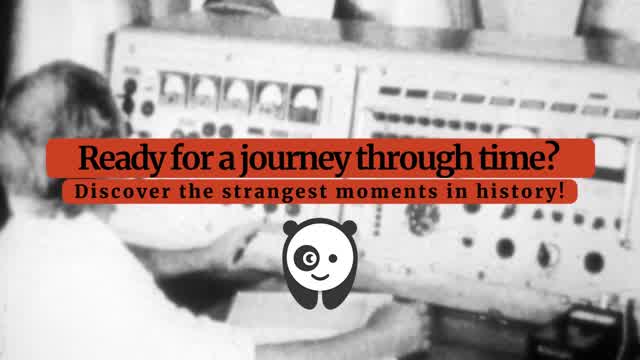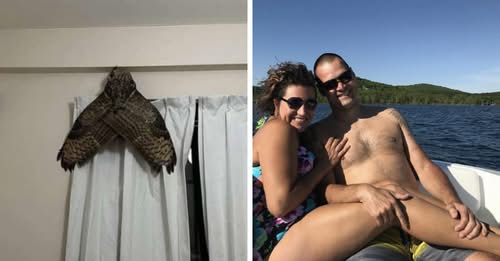As a person who has pretty high myopia, I’m used to my eyes playing tricks on me. What’s more concerning during hikes is when a person with 20/20 vision next to me points out a bird or some other critter blended in with nature that I didn’t initially see. That’s usually a recipe for a mild heart attack.
Simple things can sometimes look more interesting from certain angles, and, luckily for us, there’s an online group where folks document such photographs: the Confusing Perspective subreddit. Scroll down if you’re up for some silly and interesting visual surprises!
More info: Reddit
It’s A 3D Blanket
Dinosaurs
it In There
POST
reply
View more comments
People certainly like pictures where their brains trick them into something that isn’t really there. The Forced Perspective subreddit currently has two million members (or ‘confusers,’ as they call them). There’s one thing to note here, though: the community wants you to know they’re not about pareidolia or things that look like other things.
The Redditors here are interested in photos taken from a certain perspective which results in some kind of optical illusion. Usually, it’s what photographers call “forced perspective.” Good examples of forced perspective are photos people like to take while traveling. They manipulate the scale and depth of objects in order for them to appear smaller or bigger, closer or farther away.
My Nephew Is Half Dog Half Boy LOL
POST
reply
View More Replies…View more comments

Just An Owl Disguised As A Giant Moth To Give Someone A Heart Attack
POST
reply
View More Replies…View more comments
Lycanthrope
POST
reply
View more comments
Many filmmakers use forced perspective in their films. The Lord of the Rings trilogy is a great example, where the director Peter Jackson made the average adult-height actors look like small hobbits. It’s an optical illusion of sorts: by placing objects that are bigger farther away from the camera, you can make them smaller in scale, and vice versa.
Who hasn’t fallen into an optical illusion rabbit hole at 2 A.M. and seen the most popular ones like the classic black and white spiral, the “Rabbit or duck?” picture, or the cafe wall where every line is actually straight but appears crooked? Yet pictures aren’t the only media where our brains can’t tell if what we’re seeing is true or not. Architecture has its fair share of optical illusions, too.
A Photo I Took In An Abandoned Factory Using The Reflection In A Puddle Of Water
POST
reply
View more comments
The Cerberus Starter Pack
POST
reply
View more comments
Our Dog’s Paw Looks Like A Mini-Version Of Him
POST
reply
View more comments
Another interesting example of forced perspective is the buildings at Disneyland, the Snow White and the Sleeping Beauty castles in particular. The ground stories of both (and many other buildings in Disneyland, for that matter) are full-scale. But all the upper levels get exponentially smaller.
Defying Gravity?
POST
reply
View More Replies…View more comments
One Eyed Dog
POST
reply
View More Replies…View more comments
How Baby Cats Are Born
POST
reply
View More Replies…View more comments
What’s the point of building the Disney castles with upper stories decreasing in height? It gives off the illusion of grandeur; as you enter Main Street USA, the castle looks huge and very far away. Yet when you’re walking back from it towards the exit, the street seems much smaller and that much more manageable.
Skinwalker
POST
reply
View more comments
See-Through Newspaper?
POST
reply
View more comments
Leg Spreading In The Nude
POST
reply
View More Replies…View more comments
Do you know who else used forced perspective in architecture? The Ancient Greeks! The Parthenon, for example, has columns that are thicker in the middle than the ends and a slight bulge in their platforms. That’s so that they appear straight from a distance because parallel lines tend to appear to converge. When the columns of a building taper off at the top, the buildings would also appear larger from a distance.
I Will Take A Bite
POST
reply
View More Replies…View more comments
Catdog
POST
reply
View more comments
Wide Angle Lens Photo Makes It Seem Like The Carters Are Tiny And The Bidens Are Giants
POST
reply
View More Replies…View more comments
In optical illusions where the picture messes with our brains’ capacity to understand colors, it’s often because of our perception of lighting. Remember the famous debate about whether the dress was black and blue or white and gold? Although it was actually black and blue, many people assumed it was in a shadow and said it was white and gold.
I Now Pronounce You Man And Horse Wife
POST
reply
View more comments
The Side Of The Building Is Reflecting The Sky So Perfectly That It Looks Like It’s Two Dimensional
POST
reply
View more comments
Tiny F-15 Parked On Helicopter Rotor Blade
POST
reply
View more comments
Today, researchers can confidently say that the debate happened because of people’s assumptions about illumination. “Color perception depends on the observers’ assumptions and beliefs about the scene,” a conclusion of one study reads. Essentially, people made their decision based on whether they believed that the dress was in a shadow or not.
This Snow Angel Appears To Be Coming Out Of The Snow
POST
reply
View More Replies…View more comments
Criminal Bottle
POST
reply
View more comments
Side View Of The Pepsi-Cola Sign At Night In Queens, NYC
POST
reply
View More Replies…View more comments
Optical illusions can open an interesting and somewhat worrying can of worms: our brains can’t always differentiate between reality and illusion. Scientists say that even when we know about the trick behind the optical illusion, we still can’t unsee it. “You can’t seem to consciously override the ‘wrong’ interpretation,” neuroscientist Judy Gardner told Vox.
Smooth As A Ken Doll
POST
reply
View more comments
The Williams Tower Looks Like A Hologram In The Houston Fog
POST
reply
View more comments
Still Not Sure About Wtf Is Going On
POST
reply
View More Replies…View more comments
The reality is that our senses lag behind what’s really happening at the moment. Our brains make predictions based on the information we have, and that’s how we get optical illusions. Neuroscientist Adam Hantman says that our brains predict, and our senses correct. “If you were always using sensory information, errors would accumulate in ways that would lead to quite catastrophic effects on your motor control,” he explained.
Gigantic Boy Descends Upon A Serene Lakeshore
POST
reply
View more comments
He’s Comfortable Up There
POST
reply
View more comments

































